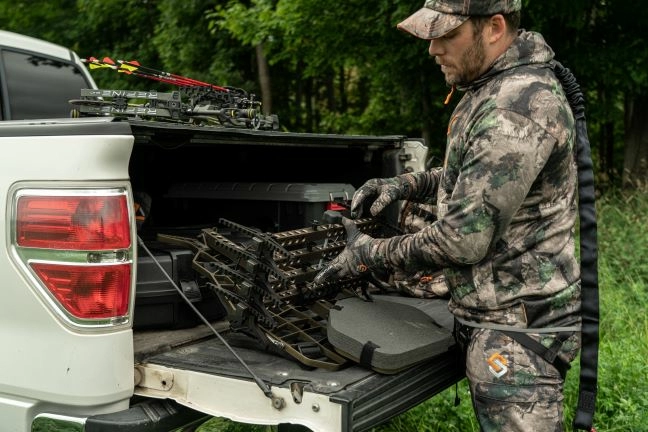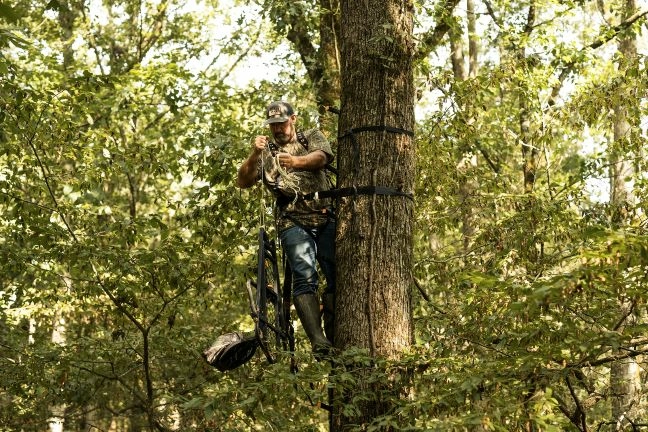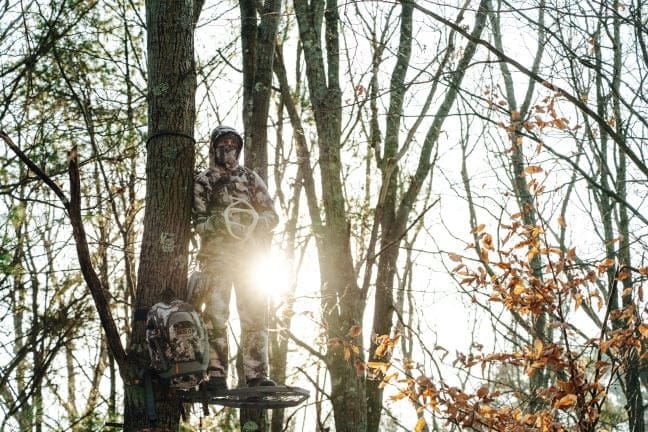Selecting the perfect tree stand location is crucial for a successful deer hunt. The right spot increases your chances of spotting deer and ensures they come within close archery range. Nothing highlights a hunter’s unpreparedness more than sitting in a tree stand, questioning if it’s the right spot. I was sitting in my stand one cool mid-October morning in southern Missouri; the bucks were active, making scrapes on the edge of the field, chasing does prematurely, and occasionally sparring with each other. It was an exciting morning, but I watched all the action through my binoculars from a few hundred yards away because my stand was on the wrong side of the field. Understanding deer behavior, seasonal patterns, and environmental factors is vital for effective stand placement. That morning, I should have positioned myself on the opposite side of the field. I had seen scrapes and rubs in that area during mid-October and should have known the deer would be more active there. It was a mistake I hoped to learn from for future hunts. To help you avoid similar errors, here’s a guide to determine the best tree stand placement for a successful hunt.

Location is the most important factor when choosing a proper stand placement. There are several reasons why choosing the proper stand location is essential other than concluding that it looks suitable for hunting.
Visibility: A well-placed stand offers a clear view of deer trails and feeding areas, increasing your chances of spotting deer.
Close Range: To ensure a successful archery shot, deer must come within archery range. Proper placement maximizes the likelihood of deer passing within shooting distance.
Wind and Scent Control: The correct location minimizes the chances of deer detecting your scent, which is critical to avoid spooking them.
Seasonal Behavior: Deer behavior changes with the seasons, so adjusting your stand location accordingly can significantly impact your success.

When picking a new stand location, use the above suggestions as a checklist to ensure the site will produce a successful hunt. Another consideration that deserves attention is whether you will see deer when the season arrives. Understanding deer patterns and habits is necessary in predicting their movements during hunting season. Here are some factors to consider:
Food Sources: Identify and monitor food sources such as acorn-producing oak trees, agricultural fields, and natural browse areas. Deer frequently visit these areas to feed, making them prime locations for stand placement.
Water Sources: Deer need water daily. Placing your stand near a reliable water source or on a travel route that leads to water can increase your chances of encountering deer.
Travel Corridors: Deer often travel along specific paths between bedding and feeding areas. Look for well-used trails and set your stand along these routes.

The next step is to get deer as close to archery range as possible. As with my hunt, I had no problem seeing a lot of deer, yet when bowhunting, seeing deer doesn’t mean you can make a successful shot. Ensuring that deer have a reason to walk by your stand within your comfortable shooting range is essential. To ensure deer come within bow range, consider the tips:
Trail Intersections: Placing your stand at the intersection of multiple trails can increase the likelihood of deer passing within range.
Cover and Concealment: Deer feel safer in areas with adequate cover. Position your stand near thick brush, fallen trees, or other natural concealments to encourage deer to move closer.
Shooting Lanes: Clear shooting lanes to ensure you have a clear path for your arrow while maintaining enough cover to stay hidden.
Seasonal timing is another factor that is difficult to determine when hanging or placing stands. Yet, it is key in determining whether you will be in the right spot when hunting seasons come around. Deer behavior varies throughout the hunting season, and adjusting your stand placement can improve your chances of success.

Early Season
During the early season, deer are less pressured and follow more predictable patterns. Focus on food sources during this time. Early in the season, deer prioritize feeding. Place your stand near food sources such as crops or mast-producing trees. Another excellent early-season stand area is near bedding areas. Position your stand between bedding areas and food sources to catch deer moving between the two.
Pre-Rut
As the pre-rut period approaches, bucks move more and establish dominance. It can be one of the most exciting for bowhunters during this time. Pre-rut is when many hunters began using
scrapes and rubs to their advantage by aiding in luring deer into close range. Look for fresh scrapes and rubs indicating buck activity. If you haven’t got your stand in the right location, move it near these areas, increasing your chances of encountering a buck.
Scrapes and rubs are keys to focus on during the pre-rut but don’t forget about the effectiveness of travel routes. Bucks are starting to expand their range. Place your stand along travel routes used by several deer. These areas are great for finding bucks marking their territory and searching for does as the rut nears.
Rut
The rut is the peak of deer activity, with bucks actively seeking out does; being in the proper position can be much more difficult because of the unpredictability of where bucks will be. One of my favorite stand areas for the peak rut is near doe bedding areas. Bucks frequently visit doe bedding areas during the rut to find a doe in heat ready to breed. After finding bedding areas, position your stand nearby to capitalize on this behavior.
Another favorite rut stand location is near funnels, and pinch points that narrow deer movement to bring bucks into close range. Natural funnels and pinch points, such as fences, water sources, and landscapes, can force deer to move through a specific area. When a hunter finds one of these areas, a stand location should be nearby.
Late Season
Deer behavior changes again as food becomes scarcer and hunting pressure increases later in the year. Late-season food sources can be one of the most effective areas to hunt during the entire season. Focus on remaining food sources, such as standing crops or areas with heavy browse. A large number of deer can often be seen during the late season when deer rely highly on food to prepare them for the harsh winter ahead.
With winter preparation in mind, dense areas, often referred to as thermal cover, can be excellent hunting spots during the late season. Deer seek out these areas to stay warm. By setting up another stand near thick, insulating cover, you’ll know exactly where to hunt when aiming to end the season with a successful harvest.
